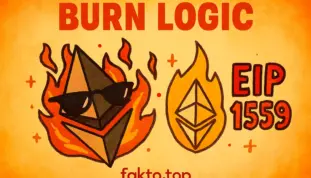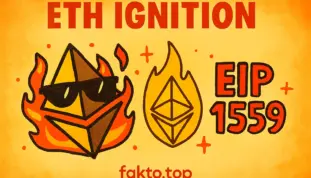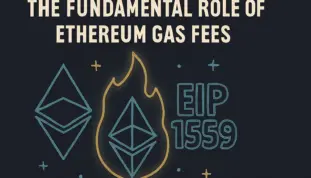EIP-1559 Explained: How ETH Burning and the Base Fee Transformed Ethereum Gas Fees
Understanding Ethereum Gas Fees: EIP-1559 and the Dynamics of ETH Burning
The Fundamental Role of Ethereum Gas Fees
Ethereum Gas Fees are the backbone of the network’s economic and security model. Every transaction or smart contract execution consumes computational effort, measured in units of Gas. This mechanism acts as an Anti-DDoS Mechanism, preventing spam and ensuring that only economically valuable operations are processed.

Before the introduction of EIP-1559, Ethereum relied on a first-price auction model. Users had to guess how much to pay to get their transaction included, often overpaying or facing unpredictable delays. This led to volatile transactional costs Ethereum and poor user experience, especially during network congestion.
To address these inefficiencies, EIP-1559 introduced a dual-fee structure and a dynamic pricing algorithm that redefined how Gas Fees are calculated and distributed.
Dynamic Pricing: How EIP-1559 Transformed Fee Calculation
At the heart of EIP-1559 is a shift from user-defined bidding to protocol-defined pricing. The new model separates the fee into two components:
- Base Fee — a mandatory minimum set by the protocol
- Priority Fee — an optional tip to incentivize validators
This structure ensures that users no longer compete on total price, but only on the Priority Fee, making costs more predictable and fair.
Another key innovation is the concept of Block Utilization. Ethereum targets 50% block fullness. If a block exceeds this threshold, the Base Fee increases; if it’s under, the Base Fee decreases. This dynamic adjustment keeps fees responsive to demand while avoiding sudden spikes.
The Base Fee Ethereum and the Gas Estimation Algorithm
The Base Fee Ethereum is a protocol-set minimum that adjusts automatically based on network usage. It is not paid to validators—it is burned, permanently removed from the supply.

The Gas Estimation Algorithm governs how the Base Fee changes:
- If the previous block is more than 50% full, the Base Fee increases by up to 12.5%
- If it’s less than 50% full, the Base Fee decreases by up to 12.5%
This algorithm ensures gradual and predictable fee changes, allowing wallets and dApps to estimate costs with high accuracy.
Example: If the Base Fee in block N is 20 gwei and block N+1 is 80% full, the Base Fee may rise to 22.5 gwei. If block N+2 is only 30% full, it may drop to ~19.7 gwei.
[VISUAL ASSET: Base Fee Adjustment Diagram]
Priority Fee (The Validator Tip)
The Priority Fee, also known as the tip, is set by the user to encourage validators to include their transaction promptly. Unlike the Base Fee, this amount goes directly to the validator.
Since the Base Fee is protocol-defined, users now compete only on the Priority Fee. This simplifies fee estimation and reduces the risk of overpayment.
Example from MetaMask: When submitting a transaction, MetaMask shows:
- Base Fee: 18 gwei (protocol-set)
- Priority Fee: 2 gwei (user-defined)
- Max Fee: 30 gwei (user cap)
This breakdown helps users understand how much they’re paying and where each part of the fee goes.
[VISUAL ASSET: MetaMask Fee Breakdown Screenshot]
The Economic Impact: The ETH Burning Mechanism
One of the most transformative aspects of EIP-1559 is the ETH Burning Mechanism. Every transaction pays:
Total Fee = Gas Units × (Base Fee + Priority Fee)
Of this total:
- The Base Fee is burned
- The Priority Fee is paid to the validator
This creates a deflationary pressure on ETH supply, especially during periods of high network activity. In some cases, more ETH is burned than issued, contributing to the Deflationary ETH narrative.

Mandatory Table: Ethereum Fee Flow after EIP-1559
| Fee Component | Determined By | Destination | Economic Impact |
|---|---|---|---|
| Base Fee | Protocol (Base Fee Ethereum Algorithm) | Burned (Removed from Supply) | Deflationary ETH Burning Mechanism |
| Priority Fee | User (As incentive) | Validator (Tip) | Inflationary (Validator Reward) |
| Gas Limit | User / Wallet Estimate | N/A | Anti-DDoS Mechanism |
[VISUAL ASSET: ETH Fee Flow Diagram]
User Control: Practical Parameters for Transaction Cost Management
While EIP-1559 improves fee predictability, users still have control over how much they’re willing to pay. Two key parameters help manage transactional costs Ethereum effectively:
Max Fee Per Gas Explained
Max Fee Per Gas is the highest amount a user is willing to pay per unit of gas. It includes both the Base Fee and the Priority Fee. If the actual Base Fee is lower than expected, the unused portion is refunded to the user.
This mechanism protects users from unexpected spikes while ensuring their transaction remains competitive.
Example from MetaMask:A user sets:
- Max Fee: 40 gwei
- Base Fee: 18 gwei
- Priority Fee: 2 gwei
Actual cost: 20 gwei. The remaining 20 gwei is refunded. This gives users peace of mind and cost control.
[VISUAL ASSET: Max Fee Refund Flowchart]
Gas Limit Transaction
Gas Limit is the maximum amount of gas a transaction can consume. It acts as a safety cap to prevent running out of gas mid-execution, which would cause the transaction to fail but still consume all allocated gas.
Wallets like MetaMask estimate the required gas based on the contract logic and suggest a safe limit. Users can manually adjust it, but setting it too low risks failure, while setting it too high may lock up funds unnecessarily.
Best Practice:Always review the suggested Gas Limit and ensure it aligns with the complexity of the transaction. For simple transfers, 21,000 gas is standard. For smart contracts, limits vary widely.
Beyond EIP-1559: The Role of Layer 2 Solutions (Rollups)
Despite EIP-1559’s improvements, the Base Fee can still spike during peak demand, especially when block space is scarce. This is where Layer 2 Solutions (Rollups) come into play.

Rollups like Arbitrum and Optimism batch hundreds of transactions off-chain and settle them on Ethereum’s Layer 1. This distributes the Base Fee across many users, dramatically reducing individual costs.
Example:On Ethereum L1, a transaction may cost 0.002 ETH.On Arbitrum, the same transaction may cost 0.0002 ETH, thanks to shared settlement overhead.
Rollups maintain Ethereum’s security guarantees while offering scalable throughput and lower fees. They are essential for mass adoption and long-term sustainability.
[VISUAL ASSET: Rollup Fee Distribution Diagram]
Conclusion
EIP-1559 has fundamentally reshaped how Ethereum Gas Fees are calculated, distributed, and understood. By introducing the Base Fee, Priority Fee, and ETH Burning, it balances economic incentives with user experience.
For traders, developers, and investors, understanding this mechanism is essential for efficient interaction with the network. Whether optimizing costs, predicting fee behavior, or analyzing ETH’s monetary policy, EIP-1559 provides the foundation for a more transparent and scalable Ethereum.
As Layer 2 solutions continue to evolve, the combination of protocol-level reform and off-chain scaling will define the future of Ethereum’s transactional economy.
Disclaimer: This article is for informational purposes only and does not constitute financial, legal, or investment advice. Readers should conduct their own research and consult professional advisors before making decisions related to Ethereum or any blockchain-based assets.
